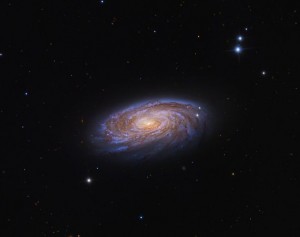A study of 544 star-forming galaxies shows that disk galaxies like our own Milky Way reached their current state as orderly rotating pinwheels much later than previously thought, long after much of the universe’s star formation had ceased
Galaxies are in no hurry to grow up, a team of astronomers has discovered. A comprehensive study of hundreds of galaxies observed by the Keck telescopes in Hawaii and NASA’s Hubble Space Telescope has revealed an unexpected pattern of change that extends back 8 billion years, or more than half the age of the universe.
Researchers say the distant blue galaxies they studied are gradually transforming into rotating disk galaxies like our own Milky Way. Until now, it had not been clear how a galaxy’s organization and internal motion change over time, said Benjamin Weiner, assistant astronomer at the UA Steward Observatory and co-author of the paper describing the findings, which are published in The Astrophysical Journal.

Galaxies start as messy, unruly teenagers and settle down into orderly spirals such as the M88 galaxy about 47 million light years away, here captured by Adam Block of the UA Mount Lemmon SkyCenter.
“When we look back very far into the distant past of the universe, we find star-forming galaxies, but they don’t look like our Milky Way, with its slowly rotating, orderly spiral disk-shape,” Weiner explained. “Instead, those earlier galaxies appear less organized, and they show more random motion, with stars, dust and gas moving up and down and sideways within the galaxy.”
“Astronomers thought disk galaxies in the nearby universe had settled into their present form by about 8 billion years ago, with little additional development since,” said Susan Kassin, an astronomer at NASA’s Goddard Space Flight Center in Greenbelt, Md., and the study’s lead researcher. “The trend we’ve observed instead shows the opposite, that galaxies were steadily changing over this time period.”
Today, star-forming galaxies take the form of orderly disk-shaped systems, such as the Andromeda Galaxy or the Milky Way, where rotation dominates over other internal motions. The most distant blue galaxies in the study tend to be very different, exhibiting disorganized motions in multiple directions. There is a steady shift toward greater organization to the present time as the disorganized motions dissipate and rotation speeds increase. These galaxies are gradually settling into well-behaved disks.
Blue galaxies – their color indicates stars are forming within them – show less disorganized motions and ever-faster rotation speeds the closer they are observed to the present. This trend holds true for galaxies of all masses, but the most massive systems always show the highest level of organization.
“Previous studies removed galaxies that did not look like the well-ordered rotating disks now common in the universe today,” Weiner said. “By neglecting them, these studies examined only those rare galaxies in the distant universe that are well-behaved and concluded that galaxies didn’t change.”
Since astronomers can’t follow the development of individual galaxies over time, they study galaxy populations.
“It’s like looking at a bunch of adults, but you want to look at them as teenagers,” Weiner said. “We want to look at galaxies when they were young.”
Rather than limit their sample to certain galaxy types, the researchers instead looked at all galaxies with emission lines bright enough to be used for determining internal motions. Emission lines are the discrete wavelengths of radiation characteristically emitted by the gas within a galaxy. They are revealed when a galaxy’s light is separated into its component colors. These emission lines also carry information about the galaxy’s internal motions and distance.
The team studied a sample of 544 blue galaxies from the Deep Extragalactic Evolutionary Probe 2 (DEEP2) Redshift Survey, a project that employs Hubble and the twin 10-meter telescopes at the W. M. Keck Observatory in Hawaii. Located between 2 billion and 8 billion light-years away, the galaxies have stellar masses ranging from about 0.3 percent to 100 percent of the mass of our home galaxy.
“We were fortunate to have so many data on a large number of galaxies from this survey,” Weiner said. “That way we could look across the population and get a fairer sample.”
Weiner wrote the computer programs that were applied to the observational data to measure the velocities of internal motions galaxies.
The Milky Way galaxy must have gone through the same rough-and-tumble evolution as the galaxies in the DEEP2 sample, and gradually settled into its present state as the sun and solar system were being formed.
“It wasn’t clear how galaxies settle down into their present, more orderly states,” Weiner said. “We now know it’s a gradual rather than a sudden process, and it happens the same for large and small galaxies.”
Now that astronomers see this pattern, they can adjust computer simulations of galaxy evolution until these models are able to replicate the observed trend. This will guide scientists to the physical processes most responsible for it.
The DEEP2 survey is led by Lick Observatory at the University of California, Santa Cruz in collaboration with the University of California,Berkeley, the University of Hawaii at Manoa, Johns Hopkins University in Baltimore, Md., the University of Chicago and the California Institute of Technology in Pasadena.
The Hubble Space Telescope is a project of international cooperation between NASA and the European Space Agency. NASA’s Goddard Space Flight Center in Greenbelt, Md., manages the telescope. The Space Telescope Science Institute in Baltimore conducts Hubble science operations. STScI is operated by the Association of Universities for Research in Astronomy, Inc. in Washington.
– By Francis Reddy and Daniel Stolte
*Source: The University of Arizona
